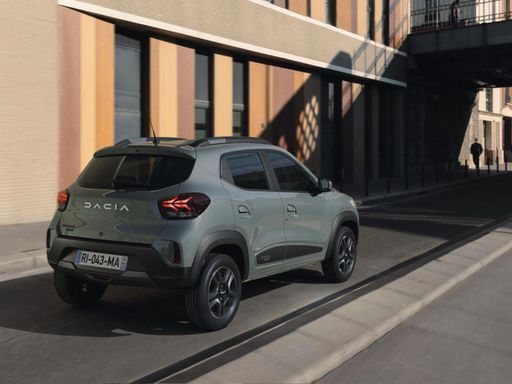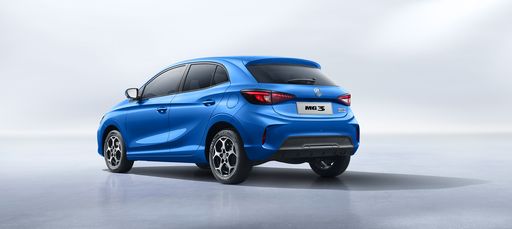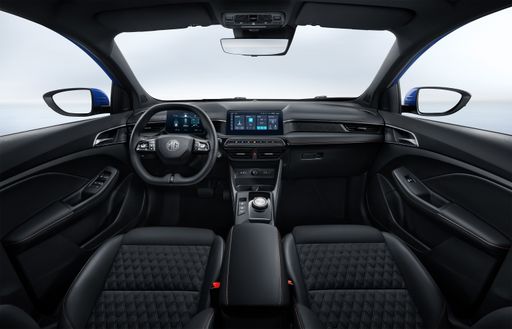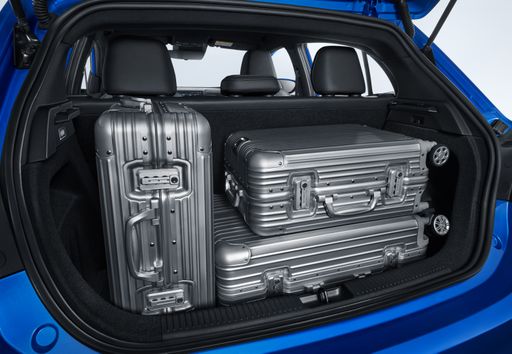Dacia Spring vs MG MG3 – Differences & prices compared
Compare performance, boot space, consumption and price in one view.
Find out now: which car is the better choice for you – Dacia Spring or MG MG3?
The Dacia Spring (SUV) comes with a Electric engine and Automatic transmission. In comparison, the MG MG3 (Hatchback) features a Full Hybrid or Petrol engine with Automatic or Manuel transmission.
When it comes to boot capacity, the Dacia Spring offers 308 L, while the MG MG3 provides 293 L – depending on how much space you need. If you’re looking for more power, decide whether the 65 HP of the Dacia Spring or the 194 HP of the MG MG3 suits your needs better.
In terms of consumption, the values are 13.20 kWh per 100 km for the Dacia Spring, and 4.40 L for the MG MG3.
Price-wise, the Dacia Spring starts at 14500 £, while the MG MG3 is available from 15400 £. Compare all the details and find out which model fits your lifestyle best!
In the rapidly evolving landscape of electric mobility, the Dacia Spring presents itself as an economical and environmentally-conscious contender, emphasizing its affordability and practical range for urban commuting. On the other hand, the MG MG3, while not an electric vehicle, offers a compelling argument for those prioritizing style and spirited driving dynamics, with its peppy petrol engine and modern interior features. Ultimately, the choice between the two will depend on whether a buyer prioritizes the green credentials and running costs of the Spring or the performance and aesthetic appeal of the MG3.
Dacia Spring
The Dacia Spring stands out as an affordable and environmentally friendly option in the electric vehicle market, combining practicality with a compact design ideal for urban settings. Its minimalist interior, while basic, provides all the essential features needed for a comfortable drive, reflecting its cost-effective approach. The vehicle's performance suits city driving, making it an appealing choice for those seeking an entry-level electric car.
details @ dacia-presse.de
@ dacia-presse.de
 @ dacia-presse.de
@ dacia-presse.de
 @ dacia-presse.de
@ dacia-presse.de
MG MG3
The MG MG3 presents itself as a vibrant and compact hatchback that's well-suited for urban environments. Its design combines a youthful aesthetic with practicality, offering a comfortable interior and a user-friendly infotainment system. With its engaging driving dynamics, it provides an enjoyable city ride that belies its budget-friendly pricing.
details @ news.mgmotor.eu
@ news.mgmotor.eu
 @ news.mgmotor.eu
@ news.mgmotor.eu
 @ news.mgmotor.eu
@ news.mgmotor.eu
 @ news.mgmotor.eu
@ news.mgmotor.eu
Rising Stars in the Urban Jungle: Dacia Spring vs. MG3
As the landscape of urban mobility continues to evolve, consumers are on the lookout for eco-friendly and versatile cars. The 2024 Dacia Spring and the MG3 each offer unique advantages, but which one is right for you? In this comparison, we'll delve into their technical specifications and innovations to help you make an informed decision.
Dacia Spring: A Pioneer in Electric Efficiency
Dacia has made a significant mark with the Spring, a model that continually impresses with its electric performance. As an SUV introduced in 2024, the Dacia Spring features an efficient electric engine with a power output of either 44 or 65 HP. This model offers a reasonable electric range, spanning 225 to 228 kilometers on a single charge from its 26.8 kWh battery.
The Spring's reduction gearbox ensures a smooth ride, complemented by its front-wheel-drive setup. A zero-emissions vehicle, it boasts an impressive CO2 efficiency class rating of A. While its acceleration from 0 to 100 km/h may not break records at 19.1 to 13.7 seconds, it stands out as a practical city car with a maximum speed of 125 km/h.
MG3: A Dynamic Performer with Hybrid Options
In contrast, the MG3, positioned as a sporty hatchback, brings power and dynamic design to the table. Available in 2024 and 2025 models, the MG3 offers two engine types: a full hybrid and a petrol, which push out either 194 or 116 HP. Its hybrid model achieves a consumption rate of 4.4 L/100km, enhancing its efficiency for long drives.
The MG3 accelerates from 0 to 100 km/h in just 8 seconds, providing a zippy alternative to the Dacia Spring. It boasts a higher maximum speed of 170 km/h, making it suitable for those craving a bit more speed on the highway. Additionally, MG has emphasized user choice with both automatic and manual transmission options.
Interior and Practicality
Both cars cater to daily urban needs, with the Dacia Spring offering a seating capacity for four passengers and the MG3 accommodating five. For storage, the Dacia provides a slight edge with 308 liters of trunk space compared to MG3's 293 liters, although the latter compensates with a higher payload capacity of 448 kg.
Interior features in both models prioritize functionality, yet the MG3 often includes additional amenities for driver comfort and connectivity, aligning with its more premium market positioning.
Dimensions and Design
Design-wise, dimensions contribute to the distinct identities of these vehicles. The Dacia Spring measures 3701 mm in length, 1583 mm in width, and 1519 mm in height, crafted as a compact SUV perfect for tight urban streets. Meanwhile, the MG3, with its 4113 mm length and 1797 mm width, offers a broader, sportier appearance befitting a hatchback.
Environmental Impact
On sustainability, the Dacia Spring's all-electric design eliminates CO2 emissions completely, placing it ahead in eco-friendliness compared to the MG3, which emits between 100 and 137 g/km of CO2, depending on the chosen engine configuration.
Conclusion: The Choice Is Yours
In conclusion, both the Dacia Spring and MG3 present compelling offerings for different consumer needs. If you prioritize sustainability and urban agility, the Dacia Spring's electric setup might suit you best. On the other hand, if performance and driving excitement are on your wishlist, the MG3, with its hybrid and petrol engines, is a thrilling option. Each vehicle brings its own set of innovations and strengths, tailored to unique user preferences in the ever-evolving automotive market.

|

|
|
|
|
Costs and Consumption |
|
|---|---|
|
Price
14500 - 17100 £
|
Price
15400 - 20600 £
|
|
Consumption L/100km
-
|
Consumption L/100km
4.4 - 6.1 L
|
|
Consumption kWh/100km
13.2 - 14.1 kWh
|
Consumption kWh/100km
-
|
|
Electric Range
225 - 228 km
|
Electric Range
-
|
|
Battery Capacity
26.80 kWh
|
Battery Capacity
-
|
|
co2
0 g/km
|
co2
100 - 137 g/km
|
|
Fuel tank capacity
-
|
Fuel tank capacity
36 - 45 L
|
Dimensions and Body |
|
|---|---|
|
Body Type
SUV
|
Body Type
Hatchback
|
|
Seats
4
|
Seats
5
|
|
Doors
5
|
Doors
5
|
|
Curb weight
1013 - 1050 kg
|
Curb weight
1237 - 1285 kg
|
|
Trunk capacity
308 L
|
Trunk capacity
293 L
|
|
Length
3701 mm
|
Length
4113 mm
|
|
Width
1583 mm
|
Width
1797 mm
|
|
Height
1519 mm
|
Height
1502 mm
|
|
Payload
265 - 302 kg
|
Payload
373 - 448 kg
|
Engine and Performance |
|
|---|---|
|
Engine Type
Electric
|
Engine Type
Full Hybrid, Petrol
|
|
Transmission
Automatic
|
Transmission
Automatic, Manuel
|
|
Transmission Detail
-
|
Transmission Detail
Automatic Gearbox, Manual Gearbox
|
|
Drive Type
Front-Wheel Drive
|
Drive Type
Front-Wheel Drive
|
|
Power HP
44 - 65 HP
|
Power HP
116 - 194 HP
|
|
Acceleration 0-100km/h
13.7 - 19.1 s
|
Acceleration 0-100km/h
8 - 10.8 s
|
|
Max Speed
125 km/h
|
Max Speed
170 - 185 km/h
|
|
Torque
113 - 125 Nm
|
Torque
148 Nm
|
|
Number of Cylinders
-
|
Number of Cylinders
4
|
|
Power kW
33 - 48 kW
|
Power kW
85 - 143 kW
|
|
Engine capacity
-
|
Engine capacity
1490 - 1495 cm3
|
General |
|
|---|---|
|
Model Year
2024
|
Model Year
2024 - 2025
|
|
CO2 Efficiency Class
A
|
CO2 Efficiency Class
C, E
|
|
Brand
Dacia
|
Brand
MG
|
Dacia Spring
The Revolution of Affordable Electric Mobility: The Dacia Spring
The automotive world has witnessed remarkable advancements in electric vehicles (EVs), with the Dacia Spring emerging as a noteworthy contender in the affordable segment. Combining efficiency, affordability, and practicality, the Spring offers an intriguing prospect for eco-conscious individuals and city dwellers alike.
Powertrain and Performance: A Look Under the Hood
The Dacia Spring is equipped with an electric motor that delivers between 44 to 65 PS, translating into a versatile driving experience tailored to urban landscapes. It operates on a front-wheel-drive system, ensuring a familiar and manageable handling experience.
Dacia Spring's electric engine is paired with an automatic transmission, utilising a reduction gearbox. This setup allows for smooth acceleration and a top speed of 125 km/h, ensuring that everyday driving scenarios are handled with ease.
Efficiency and Range: Eco-Friendly without Compromise
Efficiency is a cornerstone of the Dacia Spring's design, boasting an energy consumption of just 13.2 to 14.1 kWh per 100 km. When fully charged, its 26.8 kWh battery offers a respectable range of 225 to 228 km, making it ideal for daily commutes and short trips.
Furthermore, the Spring takes pride in its commendable CO2-efficiency class A, emphasising its commitment to reducing environmental footprint with a zero-emission profile.
Design and Practicality: Compact yet Comprehensive
Lying in the SUV category, the Dacia Spring is compact with dimensions of 3701 mm in length and 1583 mm in width, making it a perfect match for urban environments where space is at a premium. Despite its modest size, it provides a generous boot space of 308 litres, ensuring practicality isn’t sacrificed.
Comfort and Interior: For the Everyday Journey
The Dacia Spring comfortably seats up to four passengers. The cabin offers a minimalist yet functional design, available in multiple trim lines including Essential, Expression, and Extreme, allowing customers to choose according to their taste and requirement.
With its ergonomic layout and simplicity, the interior is crafted to enhance the driving experience by focusing on essential needs, avoiding unnecessary distractions.
Affordability and Accessibility: Breaking Barrier
The Dacia Spring stands out in the electric vehicle market due to its affordability, with prices ranging from 16,900 to 19,900 €. This ensures that environmentally friendly transportation is accessible to a broader audience.
Additionally, the Spring allows for cost-effective maintenance and operational expenses, offering monthly running costs between 570 to 599 € and cost per km between 22.8 to 24 cents, making it an economical choice in the long run.
Final Thoughts: The Future of Urban Mobility
In summary, the Dacia Spring serves as a testament to how electric vehicles can be both affordable and practical, without compromising on essential features. Whether it is for the eco-conscious urbanite or those looking for a cost-effective daily driver, the Spring is positioned as a viable solution for navigating the future of urban mobility.
MG MG3
An Introduction to the MG MG3: Compact yet Powerful
The MG MG3 2024 stands as a testament to how compact vehicles can blend style, efficiency, and power. The model, available as a sleek hatchback, promises a thrilling driving experience while maintaining eco-friendly standards. With its cutting-edge hybrid technology and robust powertrain, the MG MG3 is strategically designed to cater to motorists who desire both performance and sustainability.
Innovative Hybrid Technology
The MG MG3 features a full-hybrid engine, harnessing the best of both worlds with its gasoline and electric power sources. The automatic transmission ensures seamless gear transitions, providing a smooth and efficient ride. With a remarkable output of 194 PS (143 kW), the MG3 offers a powerful driving experience that is sure to impress even the most discerning drivers.
Fuel Efficiency and Environmental Impact
Efficiency is a key highlight of the MG MG3. With a fuel consumption of just 4.4 L/100km, this vehicle is engineered to keep running costs low and reduce environmental impact. The model adheres to a CO2 emission rate of 100 g/km, earning it a respectable CO2-efficiency class C. This makes it a highly attractive option for those conscious about their carbon footprint.
Performance and Dynamics
The MG MG3 accelerates from 0 to 100 km/h in just 8 seconds, delivering impressive agility for quick urban manoeuvres and confident motorway drives. The vehicle's front-wheel-drive system, coupled with a maximum speed of 170 km/h, ensures that drivers can enjoy both stability and exhilaration. The automatic gearbox enhances the overall responsiveness of the car, making each journey effortless.
Comfort and Interior Features
Balancing performance with comfort, the MG MG3 includes a variety of interior options across its trim levels: Automatik, Comfort Automatik, and Luxury Automatik. Designed to seat five passengers comfortably, this hatchback offers a surprisingly spacious interior given its compact exterior dimensions of 4113 mm in length, 1797 mm in width, and 1502 mm in height.
Practicality and Boot Space
Despite its compact size, the MG MG3 does not compromise on practicality. It features a boot capacity of 293 litres, perfect for everyday use or weekend getaways. The vehicle's design optimizes the available space, offering both driver and passengers a comfortable and functional environment.
Pricing and Value for Money
With a price range starting from €19,990 to €23,990, the MG MG3 offers significant value for money. Its balance of performance, efficiency, and modern technology makes it an attractive choice for budget-conscious buyers looking for a reliable yet dynamic vehicle that meets contemporary demands.
Conclusion: A Smart Choice for Urban Mobility
The 2024 MG MG3, with its innovative hybrid setup, excellent fuel efficiency, and robust performance, is perfectly crafted for urban dwellers seeking a stylish and reliable mode of transportation. As a hatchback, it encapsulates what modern drivers need: a blend of technology, practicality, and sustainability, all wrapped up in a competitively priced package.
Which drive types are available for the Dacia Spring?
Available as Front-Wheel Drive.
The prices and data displayed are estimates based on German list prices and may vary by country. This information is not legally binding.
